May 20, 2025 | 12:44 GMT +7
May 20, 2025 | 12:44 GMT +7
Hotline: 0913.378.918
May 20, 2025 | 12:44 GMT +7
Hotline: 0913.378.918

Dr. Tran Minh Hai, Vice Rector of the Institute for Public Policy and Rural Development under the Ministry of Agriculture and Rural Development. Photo: Nguyen Thuy.
Dr. Tran Minh Hai, Vice Rector of the Institute of Public Policy and Rural Development under the Ministry of Agriculture and Rural Development, shared with the Vietnam Agriculture Newspaper about Vietnam’s current situation in rice production linkages.
As a person who has stuck with the agriculture sector for a long time and often works with farmers, cooperatives, and businesses nationwide, Dr. Tran Minh Hai understands their difficulties as well as opportunities in the current context.
At the beginning of the story, Dr. Tran Minh Hai couldn't help but worry that currently, there are still many farmers with small and fragmented cultivation, a lack of cooperation, and not following standards. They can “break the deal” anytime if the price is higher than VND 100–200/kg.
There are still many opportunistic businesses that do not participate in the chain, "live from hand to mouth" according to each deal, and do not think about long-term sustainable development. In fact, businesses now lack standard raw materials (food hygiene and safety, traceability, etc.) for pre-processing, processing, and export, while farmers have a surplus. Therefore, the two sides cannot "meet each other".
Dr. Tran Minh Hai affirmed the necessity of linking rice production according to the value chain and considered this an important and sustainable direction to help Vietnam, especially the Mekong Delta provinces, adapt to climate change. However, Dr. Hai frankly pointed out that current models of linking rice production according to the value chain nationwide are still quite modest.
The proof is that the whole country currently has 180 businesses allowed to export rice, of which only 50 report having production linkage chains, but in fact, that number is under 50, which will be potentially risky and unsustainable for all agents in the chain, from farmers to cooperatives and businesses.
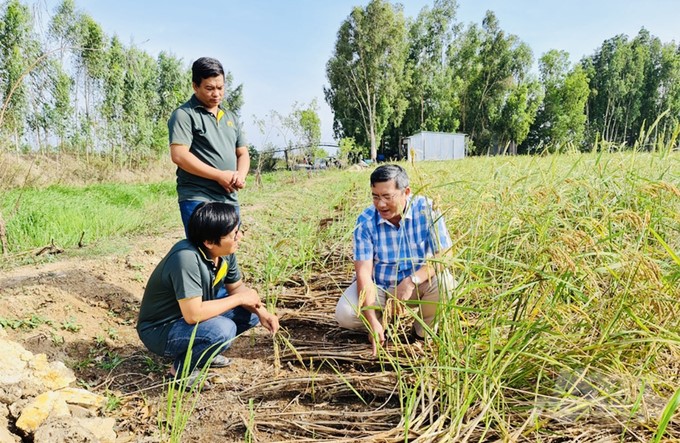
Dr. Tran Minh Hai and Loc Troi staff visited the rice-growing model in Tri Ton district, An Giang province. Photo: Le Hoang Vu.
Dr. Hai said that there are now four difficulties for businesses in purchasing rice: first, the pressure for businesses on kilns, machinery, mechanization, boats, etc. when seeding simultaneously at the same time; second, when harvesting, many farmers still leave a few fresh and green rice grains, which are easily susceptible to fungus and mold, causing bacterial infections for all quality rice (such as amatoxin-toxic fungus); third, farmers require 100% payment when delivering rice; and fourth, many cooperatives cannot issue invoices to businesses.
In the opposite direction, the fact is that many businesses still "live from hand to mouth" and do small deals. When the market price increases, they can pay more VND 100–200 /kg of rice to buy rice from farmers without having to pay the costs of following the chain.
Analyzing the reason for the small number of enterprises participating in the rice production linkage chain, Dr. Tran Minh Hai said that there are many reasons, but one of the most important is that enterprises have not yet earned benefits and profits when participating in the chain with farmers. Currently, there are no preferences for businesses following the chain, no sanctions to handle dumping enterprises, nor are there sanctions to protect businesses doing decently, so the risk for businesses is very great.
Secondly, farmers like to work alone and grow up to 5–6 varieties, not 1 variety, on one land area. Thirdly, cooperatives are now not capable of providing services or supporting businesses. Finally, committees and local authorities at the commune and district levels have not yet sat down with enterprises to remove difficulties in the process of implementing production linkage chains.
According to Dr. Hai, Vietnam still has many opportunities but has not yet fully exploited them. When Vietnam joined the EVFTA free trade agreement, European countries allowed the import quota of 100,000 tons of rice with a tax rate of 0%. But in 2021, Vietnam only exported about 20,000 tons to European countries, while Cambodia exported 155,000 tons. By 2022, Vietnam exported to Europe about 31,000 tons of rice (while Cambodia exported 221,000 tons), with prices ranging from USD 1,000 to USD 1,300/ton. In 2022 alone, Vietnam only earned USD 3.49 billion from rice exports.
Dr. Hai affirmed that any enterprise or cooperative that builds raw material areas and production linkage chains will earn much larger profits and sell products in many demanding markets at higher prices.
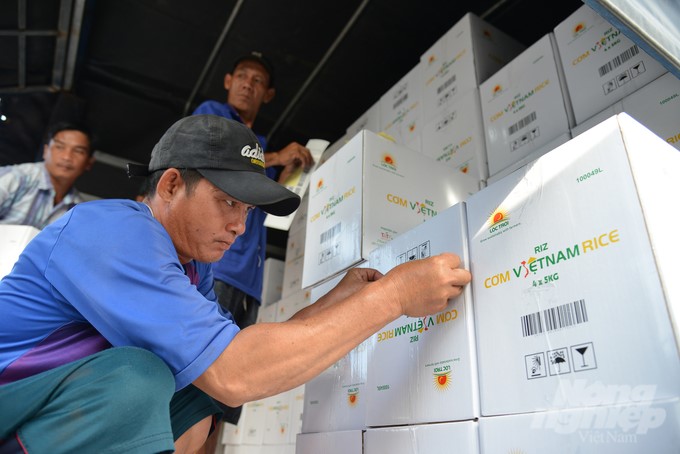
Loc Troi Group exports "Com Vietnam Rice" rice to the European market. Photo: Loc Troi.
For the first time in 30 years of rice export, in June 2022, Loc Troi Group exported "Com Vietnam Rice" rice directly to the European market, marking a major milestone in the entire agricultural production value chain of Loc Troi in particular and Vietnam's rice industry in general and helping to greatly increase the value of Vietnamese rice. One of the things that makes Loc Troi successful today is the rice production linkage according to the value chain. Currently, Loc Troi cooperates with about 200,000 farmers to build a rice raw material area on an area of about 250,000 hectares.
It is when the raw material area is built, consistent with the same variety, that cooperatives and businesses can complete the production value chain, standardize standards and quality, and control input fertilizers, along with faster application procedures, faster synchronous application of mechanization and technology, reducing input costs, applying digital technology to record seeding and harvesting times, being proactive in drying facilities, etc.
Growing area planning helps Vietnamese rice meet the requirements of electronic production logs, traceability, scientific farming, and increasing yield and quality suitable for each market, thereby helping to compete on prices and create a brand for Vietnamese rice in the domestic and world markets. In particular, planning helps Vietnamese rice stabilize its output, ready to be marketed in demanding markets and sold at higher prices.
On the other hand, the Ministry of Agriculture and Rural Development is currently supporting businesses and cooperatives with projects to implement mechanization. If taking advantage of the projects to build a large raw material area, it will be convenient to apply mechanization, spraying drones, technology, etc. to rice production. In short, there are many benefits to building a raw material area.
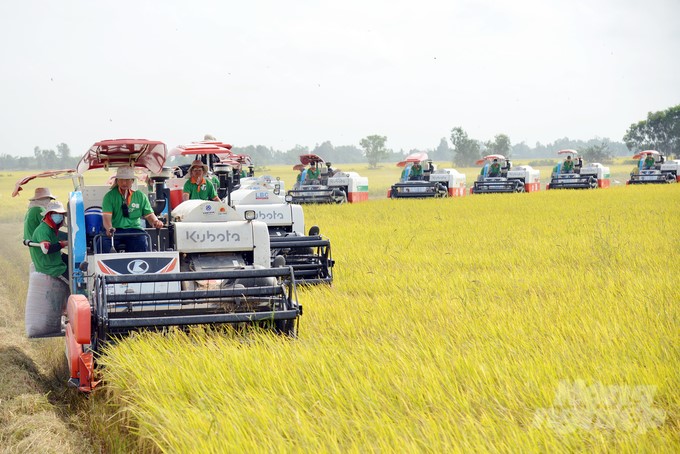
Loc Troi Group's harvesters in fields of rice exported to the EU.
As for localities, according to Dr. Tran Minh Hai, in the long term, provinces must make soil nutrient maps. "It is this map that can analyze nutrients and heavy metal contamination of soil above the surface layer of 0.5m and 1m. Based on this map, product stories will be built when growing rice. At this time, we no longer sell products but sell product stories. This is a major problem that other places have not paid attention to," Dr. Hai said.
According to Mr. Hai, each province must plan large rice production areas in some localities in association with cooperatives, thereby creating favorable conditions for enterprises in terms of capital, dredging canals, and 3-phase power lines to build pumping stations, combined with the new rural construction program to form traffic roads and canals, in order to apply mechanization to production. At the same time, it is necessary to improve the capacity of providing services for cooperatives, such as cooperatives to self-organize their combine harvesters, self-mobilize people to deliver standard rice and commit to timely delivery of rice to the drying kilns of enterprises.
To increase the chain\'s connectivity, local authorities’ participation is required. "If wishing businesses and people to cooperate in rice growing, the secretary and chairman, especially the People\'s Committees of districts and communes, should proactively meet with businesses. Currently, some leaders of District Party Committees and People\'s Committees of communes and districts in some localities have met with businesses to promote trade and invite businesses to join the chain. This is a good guideline that needs to be promoted. From there, local authorities develop solutions to timely support infrastructure and capital," Dr. Hai shared.
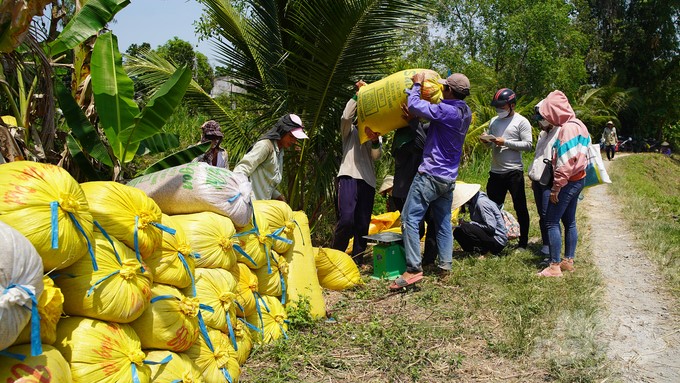
According to statistics, on average nationwide, a cooperative has 192 members. Particularly in the Southern region, a cooperative has fewer than 100 members. Photo: Dang Tuan Anh.
Currently, the Ministry of Agriculture and Rural Development has a program to build a large raw material area of rice in the Long Xuyen Quadrangle, fruit trees in the Dong Thap Muoi area, coffee in the Central Highlands, etc. Dr. Tran Minh Hai suggested that large raw material area should be promoted in other industries. Especially for the "Project of 1 million hectares of rice in the Mekong Delta", it is necessary to focus on policies to support and improve the quality of rice grains, thereby attracting more enterprises participating in the chain.
As for the Ministry of Agriculture and Rural Development, Dr. Tran Minh Hai proposed that there should be policies to support and strengthen the application of mechanization and digital technology in traceability and production management. At the same time, promote communication of good models, models of people and businesses working in chains, to encourage individual businesses to join the chain.
In particular, it is necessary to invest more in business capacity for cooperatives to act as partners for businesses. " For the rice industry, if wishing to improve the business capacity of cooperatives, first, the Ministry of Agriculture and Rural Development must have a policy on the Law on Cooperatives in June 2023 to take effect next year and require localities to prepare land funds for cooperatives,” said Dr. Hai.
Currently, countries are tightening rice exports and rice prices are increasing, but only about 20% of farmers benefit from increased rice prices. Many remaining farmers mainly sell young rice, so they do not benefit. Businesses also face difficulties due to a lack of quality raw materials. Only the brokers are disrupting the market.
Therefore, Dr. Tran Minh Hai said that there is no other way to solve the problem than for farmers to participate in cooperatives, closely linking between cooperatives and businesses to improve quality in the chain, and long-term cooperation to jointly share and benefit. "Quality, quality, and quality; cooperation, cooperation, and cooperation” is the advice Dr. Tran Minh Hai offered to farmers, cooperatives, and businesses in the current context.
Translated by Huyen Vu Thu

(VAN) For years, the CRISPR-Cas9 genome technology has been reshaping genetic engineering, a precision tool to transform everything from agriculture to medicine.
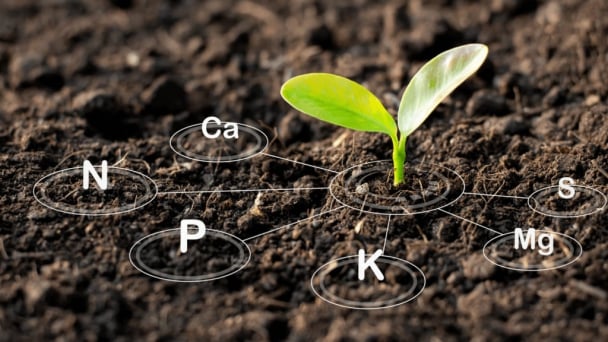
(VAN) Vietnam aims to become a 'leader' in the region in the capacity and managing effectively soil health and crop nutrition.
![Reducing emissions from rice fields: [Part 1] Farming clean rice together](https://t.ex-cdn.com/nongnghiepmoitruong.vn/608w/files/news/2025/05/05/z6509661417740_a647202949c539012a959e841c03e1d3-nongnghiep-143611.jpg)
(VAN) Growing clean rice helps reduce environmental pollution while increasing income, allowing farmers to feel secure in production and remain committed to their fields for the long term.
/2025/05/19/5136-1-144800_230.jpg)
(VAN) The Nghe An Provincial People's Committee has just approved the list of beneficiaries eligible for revenue from the Emission Reductions Payment Agreement (ERPA) in the North Central region for the year 2025.
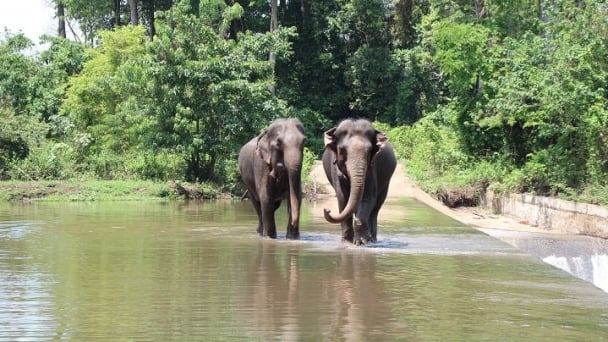
(VAN) 14 out of 35 domesticated elephants in Dak Lak province have had their living conditions improved, with 11 of them currently participating in the non-riding elephant tourism model.

(VAN) Muong Nhe Nature Reserve hopes that being upgraded to a national park will lay the foundation for forest protection efforts to be carried out in a systematic, modern, and sustainable manner.
/2025/05/16/3923-2-171845_52.jpg)
(VAN) Lower costs, higher yields, and improved soil quality are outstanding benefits that soybeans bring when integrated into the crop rotation system.